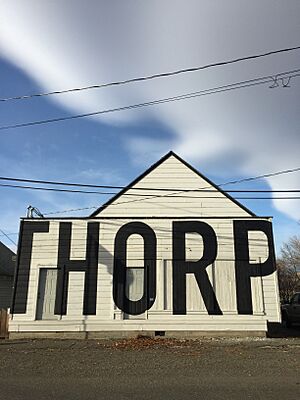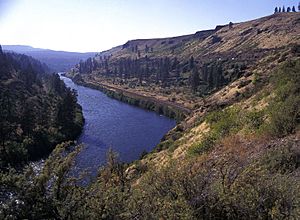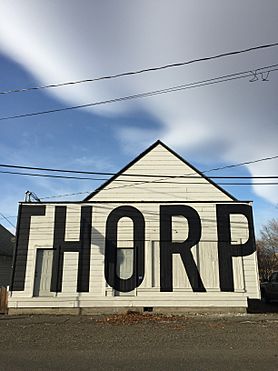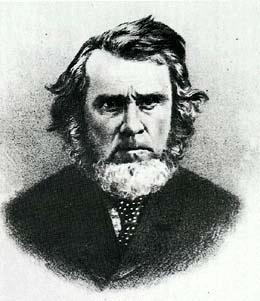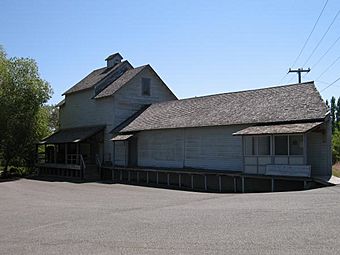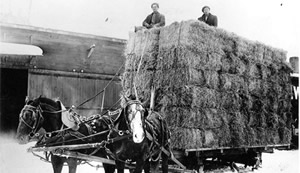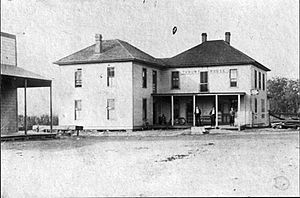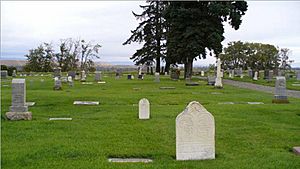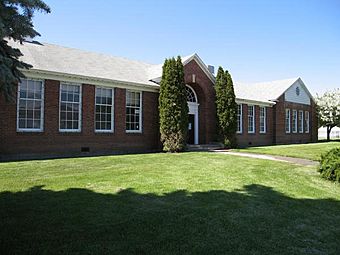Thorp, Washington facts for kids
Quick facts for kids
Thorp, Washington
(Native American Name: Klála)
|
|
|---|---|
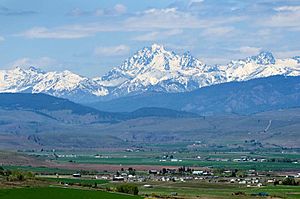
View of Thorp with Mt. Stuart in distance.
|
|
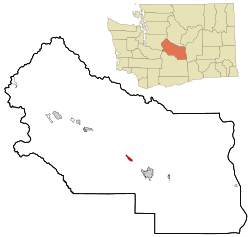
Location of Thorp, Washington
|
|
| Country | |
| State | |
| County | Kittitas |
| Settled | 1868 |
| Platted | July 9, 1895 |
| Named for | Fielden Mortimer Thorp |
| Area | |
| • Total | 1.2 sq mi (3.2 km2) |
| • Land | 1.2 sq mi (3.2 km2) |
| • Water | 0 sq mi (0.0 km2) |
| Elevation | 1,637 ft (499 m) |
| Population
(2020)
|
|
| • Total | 232 |
| • Density | 188/sq mi (72.5/km2) |
| • Demonym | Thorpite Thorpian |
| Time zone | UTC-8 (Pacific (PST)) |
| • Summer (DST) | UTC-7 (PDT) |
| ZIP code |
98946
|
| Area code(s) | 509 |
| FIPS code | 53-71225 |
| GNIS feature ID | 1527125 |
Thorp is a small community in Kittitas County, Washington, United States. It's called an "unincorporated community" because it doesn't have its own city government. It's also a "census-designated place" (CDP), which means the United States Census Bureau counts its population for statistics. In 2020, 232 people lived there.
Thorp is about 100 miles (160 km) east of Seattle. It sits at the western edge of the Kittitas Valley. This area is known for its farms, which grow hay, alfalfa, vegetables, and fruits.
The town is named after Fielden Mortimer Thorp. He was the first permanent white settler in the Kittitas Valley, arriving in 1868. Before that, a large Native American village called Klála was located nearby.
Contents
Exploring Thorp's Geography
Thorp is located at 47°4′5″N 120°40′22″W / 47.06806°N 120.67278°W. It covers about 1.2 square miles (3.2 km²), all of which is land. The town sits above the Yakima River at an elevation of 1,637 feet (499 m). It's near the start of the Yakima River canyon.
To the southwest, you'll find Taneum Canyon. The city of Ellensburg, the county seat, is southeast of Thorp. The Yakima River flows out of a canyon northwest of Thorp. This area has interesting rock formations made of basalt.
Land and Landscapes
North of Thorp, the land gradually rises. This area shows where a very old glacier once stopped, about 600,000 years ago. The ground here is made of "Thorp Gravels," which are layers of gravel and sand. These layers are between 3 and 4 million years old. They are not very solid and can easily slide.
This area is home to lots of wildlife. You can see bald eagles and osprey hunting along the river. Deer and elk also cross here, especially at dawn and dusk.
West of Thorp, you start to see the Columbia River Plateau. This huge plateau formed when lava flowed out of cracks in the ground millions of years ago. Later, volcanoes in the Cascade Range erupted, adding layers of ash and mud.
Interstate 90 passes through the Thorp area. As you travel from Snoqualmie Pass to Thorp, the elevation drops a lot. The amount of rain and snow also decreases significantly.
The land then opens up into the Kittitas Valley. This valley is filled with river gravel from the ancient Yakima River. It's a large basin between Mission Ridge to the north and Manastash Ridge to the south.
Thorp's Climate
| Weather chart for Thorp, Washington | |||||||||||||||||||||||||||||||||||||||||||||||
|---|---|---|---|---|---|---|---|---|---|---|---|---|---|---|---|---|---|---|---|---|---|---|---|---|---|---|---|---|---|---|---|---|---|---|---|---|---|---|---|---|---|---|---|---|---|---|---|
| J | F | M | A | M | J | J | A | S | O | N | D | ||||||||||||||||||||||||||||||||||||
|
7.9
34
17
|
6.4
38
25
|
5.4
42
27
|
1
49
31
|
1.2
62
38
|
1.4
65
44
|
0.1
77
52
|
0.1
72
48
|
0.4
67
44
|
4.6
53
34
|
5.3
43
29
|
9.1
36
26
|
||||||||||||||||||||||||||||||||||||
| temperatures in °F precipitation totals in inches |
|||||||||||||||||||||||||||||||||||||||||||||||
|
Metric conversion
|
|||||||||||||||||||||||||||||||||||||||||||||||
Thorp has mild summers and very cold winters. In July, the warmest month, temperatures average around 77.2°F (25.1°C). In January, the coldest month, temperatures average around 16.5°F (-8.6°C).
During summer, the temperature can change a lot between day and night, sometimes by 30°F (16°C). In winter, temperatures often stay around or below freezing.
Rainfall changes a lot throughout the year. December and January get the most rain and snow. Summer months, especially July, are very dry, with less than half an inch of rain.
Neighboring Areas
 |
Roslyn |
Yakima River |  |
|
| Sunlight Waters Thorp Prairie |
||||
| Taneum Canyon Taneum Creek |
Ellensburg Kittitas |
Thorp's Population
In 2000, Thorp had 273 people living in 103 households. About 44.7% of households had children under 18. Most households (56.3%) were married couples.
The population included people of different ages. About 33% were under 18, and 9.2% were 65 or older. The average age was 36 years old.
The average income for a household was $33,125. About 5.9% of the population lived below the poverty line.
Thorp's History
Native American Life
The Kittitas Valley was home to the Kittitas tribe, also known as the Upper Yakama. Other tribes like the Cayuse and Nez Perce also visited for hunting and gathering food. The valley was rich in wild berries, fish, and game. Tribes would gather in April or May to harvest plants like Indian onions and potatoes. They also traded horses with early British and American fur traders.
In the 1840s, white settlers arrived, bringing diseases like measles that were deadly to the Native American population. Differences in culture, like plowing the ground (which Native Americans saw as harming the earth's spirit), also led to conflicts.
The largest Native American village in the valley was Klála, with about 500 people. It was located about a mile from where Thorp is today, along the Yakima River. Other villages, Tátxanixsha and Yumi'sh, were also nearby.
In 1858, during the Yakima War, a large group of Wanapum people camped near present-day Thorp. They were led by Smohalla, a famous prophet. Smohalla believed he received visions through dreams. He taught his people to return to their old ways of life, before white influences.
A preacher named George W. Kennedy visited Smohalla's camp to try and make peace. Smohalla asked, "Why has the white man taken our lands from us? Has the white man any rights here in Kittitas that the Indian has any right to respect? The Indian came first." Kennedy agreed it was a powerful question. They shook hands as a sign of peace.
Early Settlers and Pioneers
Few pioneers came to the Kittitas Valley until the mid-1850s. In 1853, the first wagon trains passed through. George B. McClellan also surveyed the valley for the Northern Pacific Railroad.
Fielden Mortimer (F. M.) Thorp is known as the first white settler in the Yakima Valley. In 1868, he and Charles Splawn became the first permanent white settlers in the Kittitas Valley. They built their homes near Taneum Canyon. This spot was perfect for their cattle and for farming. Charles Splawn also ran a "roadhouse" here, which was a place for travelers to stop overnight.
Other early settlers soon joined them, including Walter J. Reed, who later founded Cle Elum. The first post office in the Kittitas Valley, called Taneum Station, was set up at F. M. Thorp's home in 1869.
Antoine Bertram, a Yakama Indian, moved to the Thorp area with the Splawn and Thorp families. He helped them with their cattle. Another friendly Indian, Keneho, was paid to carry mail over the Snoqualmie Trail.
A mysterious grave in Taneum Canyon marks "A White Woman's Grave." This woman was the wife of Al Williams, who died in 1870 when her horse stumbled. Years later, a marker was placed to protect the grave. Today, it's a small fenced area on land owned by the Washington Department of Natural Resources.
The Thorp-Splawn Pioneer Cemetery is about a mile southwest of Thorp. It has four marked graves for the Splawn and Thorp families, plus twelve unmarked graves. The cemetery was restored in 1964.
Other early settlers included Herman Page, J. H. Stevens, and John C. Goodwin, who became the first sheriff of Kittitas County. The first marriage license in Kittitas County was given to John Ellison and Amy Childs of Thorp in 1884.
In the 1870s, the Thorp area was known as Pleasant Grove. The Pleasant Grove post office was established in 1872. For the next ten years, the area remained mostly cattle ranches.
By the early 1880s, farming grew, and the open land for cattle began to shrink. In 1880, the post office moved closer to a small business area. This area had a sawmill and, three years later, a gristmill. People hoped a railway would soon come through.
Mill Town and Railroad Era
In 1878, James L. Mills saw potential in the Kittitas Valley. He built a sawmill west of Thorp in 1879, using water from the Yakima River to power it. The sawmill could produce 7,000 feet of lumber daily.
Mills also used the same water power for the North Star Mill, a gristmill built by Oren Hutchinson in 1883. This mill made feed for animals and flour for people. Its most famous brand was "Tip Top."
The post office, first called Milton, was moved near the mills in 1880. In 1884, it was moved to the gristmill and renamed "Oren." In 1889, its name changed to "Thorp" to match the name the Northern Pacific Railroad used. In 1895, the post office moved again to the new train station area.
Water systems were key to the mills and farms. The Manastash Canal was finished in 1875. The Westside irrigating canal, which runs south of Thorp, was started in 1889. It uses water from the Yakima River and is about 14 miles long.
The town of Thorp largely exists because of the Northern Pacific Railroad. In 1887, the railroad reached Thorp. It took two years to build the line to Thorp. Chinese laborers helped build the railroad lines. A section house in Thorp housed the regular crew, while Chinese laborers had their own sleeping cars.
In 1895, the main railroad line was extended, and the train station moved to the current town site. The town grew around this station, with maintenance buildings and warehouses.
The Newman family settled the current town site in 1878. On July 9, 1895, John M. and Sarah Isabel Newman planned out a three-block town around the train station. Later, Milford A. Thorp, F. M. Thorp's son, added more land to the town. Homes and businesses quickly appeared.
The first store in Thorp opened around 1895. The first hotel, the Thorp House, was established in 1893.
In 1907, the North Star Mill's water wheel began powering a dynamo. This provided electricity for laundry and lights. Thorp was one of the first towns in Washington to have electric lights, and the smallest unincorporated town in the Northwest to do so!
In 1909, the Milwaukee Road also built a depot in Thorp. This made Thorp an important shipping point, as both major railroads crossed paths there.
The U.S. Postal Service used Northern Pacific railroad cars to carry mail to Thorp. Special hooks on the trains would grab mailbags without stopping. Passenger trains also ran daily, stopping in Thorp.
Boomtown and Beyond
In the early 1900s, Thorp's economy remained steady, with its population reaching about 400 people.
In the late 1920s and 1930s, Thorp saw an economic boost, even during the Great Depression. This growth came from timber workers from Taneum Canyon. In 1928, Thorp became a headquarters for a project to build the Highline Canal, bringing more activity.
Also, Camp Taneum, a Civilian Conservation Corps camp, was set up nearby. It brought up to 189 young men, many of whom visited Thorp for shopping and fun. The camp closed in 1938.
The economic boost led to more social places. Ellison's Hall, at Railroad Street and First Street, hosted lively "smokers" on Saturday nights. It also held parties, dances, and events for the Ladies' Aid Society.
On May 24, 1938, a serious fire destroyed several businesses, including the Thorp Hotel. Another fire on August 16, 1943, burned another commercial building.
These fires led to the creation of Kittitas County Fire District No. 1 in 1943, the oldest fire protection district in the state. The volunteer fire department's small fire house had a large bell from the old Thorp school. The original fire house is now an artist's studio.
The boomtown days ended after World War II, as logging operations slowed and canal workers left. Many businesses closed.
The Northern Pacific Railroad depot in Thorp officially closed on July 1, 1952. The railroad said fewer shipments and competition from trucks were the reasons.
In 1967, the Ellensburg Telephone Company built a new telephone office on the site of the 1938 fire. It opened in 1968 and is still in use.
A new steel bridge over the Yakima River was built in 1936. This led to the Thorp Highway becoming a state highway in 1937. However, the highway through Thorp was removed from the state system in 1953.
The opening of U.S. Route 10 (now State Route 10) in 1926 and Interstate 90 in 1968 greatly changed Thorp's population and economy. In 1980, Interstate 90 from Seattle to Thorp was named the Mountains to Sound Greenway to protect its beautiful scenery.
Thorp Cemetery
The Thorp Cemetery is about a mile south of town. Herman Page, an early farmer, donated the land for the cemetery. Some graves date back to 1890.
Local stories say the cemetery is haunted by the ghost of a young Indian woman named Susie. She was tragically killed around 1890. People say she has been seen riding a white horse and crying among the tombstones on moonlit nights. The cemetery is often listed as a "haunted place" in Washington state.
The cemetery is peaceful and well-kept. It is still used for burials today. Visitors are asked to be respectful of those buried there and their families.
Churches in Thorp
| Thorp Church of Christ Charter Roll of 1895 |
|---|
| Myra Barnett, Robert Barnett, Retta Barnett, Eldora Briggs, William Briggs, Lena Burns, Frances Childs, Mary Childs, Hannah Childs, Warren Childs, George DeShazer, Nancy DeShazer, Allie Ellison, Eugene Ellison, Maud Ellison, Ruth Ellison, John Ellison, Lewis Ellison, Deborah George, Ellis George, Dee Goodwin, Lillian Goodwin, Olive Goodwin, Martha Mattox, William Mattox, Jennie Osborn, Florence Snyder, Dora Stultz, Philip Stultz and Laura Turner. |
Many Thorp families came from Oregon and were part of the Stone-Campbell Movement. The Thorp Church of Christ was formed in 1895, though people had been meeting since 1890. Mary Childs and Sarah Goodwin were key in starting the church.
Early services were held at the Thorp school house. A permanent church building was built in 1897.
The Thorp Methodist Episcopal Church also existed for many years but disbanded in the 1930s. Its building later became a Grange hall and a square dance hall. It has recently been sold and turned into a home.
In 1949, Teddy Leavitt started a short-lived Bible college in Thorp. The Thorp Church of Christ building burned down on April 13, 1950. The college then moved to Selah, Washington. The Thorp Church of Christ was quickly rebuilt in the same spot.
In 1981, the Thorp Church of Christ became the Thorp Community Church. It continues to serve the townspeople's spiritual needs.
Getting Around Thorp
You can reach Thorp by taking Exit 101 (Thorp, Thorp Highway) on Interstate 90. You can also get there from State Route 10 via the Thorp Highway.
The main line of the Northern Pacific Railroad used to run through Thorp, making it an important shipping point. Today, the Burlington Northern-Santa Fe uses the rail line, but trains no longer stop in Thorp.
Learning in Thorp
Public schools in Thorp are run by Thorp School District No. 400. The district has one junior/senior high school (Thorp High School) and one elementary school.
Fun Places to Visit in Thorp
- Thorp Community Day -- This is an annual celebration in early October, celebrating the autumn harvest. It starts with a pancake breakfast and a parade. There's a Fall Market with local vendors selling crafts, food, and antiques. The Harvest Carnival at the historic Thorp Grade School has old-fashioned games like apple bobbing. You can also visit the historic Thorp Mill and enjoy live music.
- Iron Horse State Park - This park follows the old Milwaukee Road railway line. You can access it near Interstate 90 exit 101 at Thorp. It's a great place for outdoor activities.
- The Thorp Mill - This historic grist mill is one of Kittitas County's oldest landmarks. It's listed on the National Register of Historic Places and teaches about Thorp's history.
- Thorp Grade School - Built in 1936, this building is also on the National Register of Historic Places. It still serves the children of Thorp. You can see its beautiful hardwood floors and wood-paneled gymnasium.
- Northern Pacific Depot - The old train station was moved to its current spot along Thorp Highway.
- Old Thorp Fire Station - This building housed the first fire protection district in the state, established in 1943. It's now an artist's studio and home.
- Old Thorp Post Office - Located near the old fire station, this building was the post office until the 1990s. It's now an artist studio called Thorp Collective.
- F. C. Porter Store - This dry goods store from the early 1900s is one of the oldest surviving commercial buildings. It's a classic example of old-style commercial architecture.
Images for kids
See also
 In Spanish: Thorp (Washington) para niños
In Spanish: Thorp (Washington) para niños



